| Home
> Article
> Hajj Places Where Hajj Rites Are Performed
|
| |
| Hajj Places Where
Hajj Rites Are Performed |
| |
 |
| |
| Ka’bah (Baitullah) |
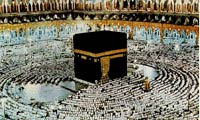 A
cubic structure, built by Prophet Ibrahim and Ishmail
on God’s (ALLAH)
command. Since then it has become the source of
peace and blessings and guidance for all mankind
and the pilgrims circle around it with utmost enthusiasm
and devotion. A
cubic structure, built by Prophet Ibrahim and Ishmail
on God’s (ALLAH)
command. Since then it has become the source of
peace and blessings and guidance for all mankind
and the pilgrims circle around it with utmost enthusiasm
and devotion. |
| |
| Masjidil Haram (Alharam
Asharief Mosque) |
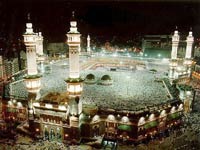 The
mosque in which Ka’bah is situated is called
Masjidil Haram. This is the holiest and biggest
mosque in the world, a vast two stories building
that can accommodate two million people. The
mosque in which Ka’bah is situated is called
Masjidil Haram. This is the holiest and biggest
mosque in the world, a vast two stories building
that can accommodate two million people. |
| |
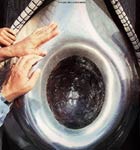 Hajar
Aswad (Black Stone) Hajar
Aswad (Black Stone)
The sacred Black Stone set about chest-high in the
eastern corner of the Ka’bah was originally
placed there by Prophet Ibrahim. It is a heavy oval
stone, of black reddish color. Its diameter is 30
cm, surrounded with a silver frame. The pilgrim
is required to kiss the black stone if possible.
It is told that the Prophet Muhammed said, "The
stone and the station of Ibrahim are bequeathed
from paradise, but ALLAH obliterated their light,
otherwise they would have lit between east and west".
He also said, "When the black stone was lowered
from paradise, it was whiter than milk, but the
sins of humans made it black”.
Tawaf is started by kissing or touching or pointing
towards the Black Stone and brought to completion
at it, after seven circles. |
| |
| Multazam |
| Multazam is the wall, about 1.5
meters in length, between Hajar Aswad and the door
of the Ka’bah. This is a highly sacred place
where prayers are accepted. The pilgrims cling to
it pressing their chests and cheeks to it and pray
humbly for the forgiveness of their sins and acceptance
of their prayers. |
| |
| Mizab Al-Rahmat |
| Mizab Al-Rahmat is the spot under
the drain of the Ka’bah’s roof. It is
a place for acceptance of prayers. |
| |
| Maqam Ibrahim (Station
of Ibrahim) |
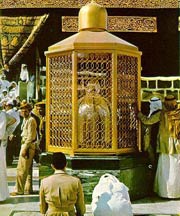 A glass and metal structure which contains a sacred
stone bearing the footprint of Prophet Ibrahim who
stood here during the construction of the Ka’bah.
It is situated to the north-east of the Ka’bah,
close to its door.
A glass and metal structure which contains a sacred
stone bearing the footprint of Prophet Ibrahim who
stood here during the construction of the Ka’bah.
It is situated to the north-east of the Ka’bah,
close to its door. |
| |
| Zamzam Water |
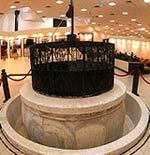 The
spring which miraculously gushed forth at Ishmail's
feet never stops gushing and continuously gushing
for thousands of years up to now, called Zamzam
water. It is only a few meters east of the Ka'bah.
Now, the well is 35 meters deep and topped by an
elegant dome. The
spring which miraculously gushed forth at Ishmail's
feet never stops gushing and continuously gushing
for thousands of years up to now, called Zamzam
water. It is only a few meters east of the Ka'bah.
Now, the well is 35 meters deep and topped by an
elegant dome.
Zamzam has provided the water to billions of people
for thousands of years up to now. One of the miracles
of Zamzam water is its ability to satisfy both thirst
and hunger. The water used to be called "Shabba'ah"
or satisfying.
The Prophet Muhammad said: "The best water
on the face of the earth is the water of Zamzam;
it is a kind of food and a healing from sickness." |
| |
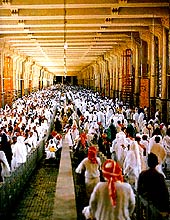 Safa
and Marwah Safa
and Marwah
Safa is a hill to the south of the Ka’bah,
which has been leveled down. Opposite to it, to
the north of the Ka’bah is Marwah. Performing
sa’i between these two hills is a principal
rite of Hajj. |
| |
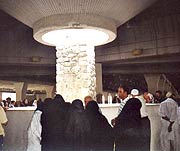 Mina Mina
Mina is a plain within the boundaries of Masjidil
Haram, about 5 km outside Mecca. The pilgrims pass
the night here between the 8th
and 9th Dzulhijjah
and then carry on to Arafat after sunrise on the
9th Dzulhijjah.
They return here on the 10th
Dzulhijjah for the 3 final days of Hajj. Animal
sacrifice is done here.
The pilgrims throw pebbles on 3 Jumrah (stone
pillars) that represent devils. These stone
pillars, representing devils, are known as Jumrah
al-Ula (small devil),
Jumrah al-Wusta (middle devil)
and Jumrah al-Aqabah (big
devil). This symbolizes Ibrahim's throwing
stones at devil when he tried to dissuade Ibrahim
from sacrificing his son. This rite is carried out
within 11th, 12th,
and 13th Dzulhijjah.
|
| |
| Arafat |
| Arafat is a vast plain about 15
km to the east of Mecca. Arrival in Arafat on the
9th Dzulhijjah
and Wuquf (halting)
herein until sunset is the most principal Hajj rite.
Without Wuquf, Hajj is not valid. At sunset, the
pilgrims leave for Muzdalifa. |
| |
| Muzdalifah |
| Muzdalifah is a place midway on
the route from Mina to Arafat. Pilgrims gather here
on the night of the 9th
Dzulhijjah on their return from Arafat. Here, they
carry out Maghrib and Isya prayers. It is a must
to stay here after Shubuh prayer (between
the break of dawn and sunrise) before going
to Mina. |
| |
| Back
to other articles |
| |
